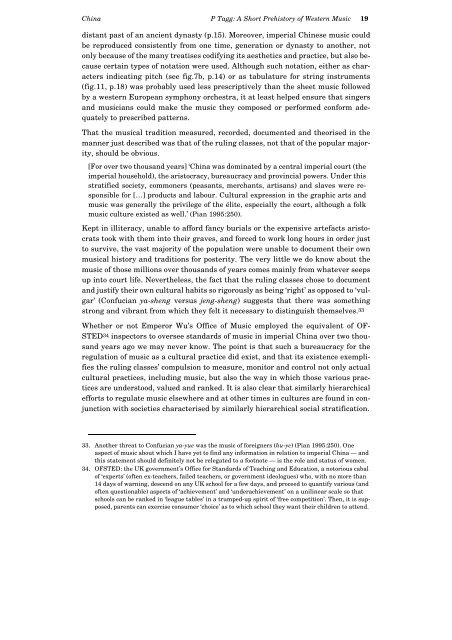A Short Prehistory of Western Music, Chapter 3
A Short Prehistory of Western Music, Chapter 3
A Short Prehistory of Western Music, Chapter 3
Create successful ePaper yourself
Turn your PDF publications into a flip-book with our unique Google optimized e-Paper software.
China P Tagg: A <strong>Short</strong> <strong>Prehistory</strong> <strong>of</strong> <strong>Western</strong> <strong>Music</strong> 19<br />
distant past <strong>of</strong> an ancient dynasty (p.15). Moreover, imperial Chinese music could<br />
be reproduced consistently from one time, generation or dynasty to another, not<br />
only because <strong>of</strong> the many treatises codifying its aesthetics and practice, but also because<br />
certain types <strong>of</strong> notation were used. Although such notation, either as characters<br />
indicating pitch (see fig.7b, p.14) or as tabulature for string instruments<br />
(fig.11, p.18) was probably used less prescriptively than the sheet music followed<br />
by a western European symphony orchestra, it at least helped ensure that singers<br />
and musicians could make the music they composed or performed conform adequately<br />
to prescribed patterns.<br />
That the musical tradition measured, recorded, documented and theorised in the<br />
manner just described was that <strong>of</strong> the ruling classes, not that <strong>of</strong> the popular majority,<br />
should be obvious.<br />
[For over two thousand years] ‘China was dominated by a central imperial court (the<br />
imperial household), the aristocracy, bureaucracy and provincial powers. Under this<br />
stratified society, commoners (peasants, merchants, artisans) and slaves were responsible<br />
for […] products and labour. Cultural expression in the graphic arts and<br />
music was generally the privilege <strong>of</strong> the élite, especially the court, although a folk<br />
music culture existed as well.’ (Pian 1995:250).<br />
Kept in illiteracy, unable to afford fancy burials or the expensive artefacts aristocrats<br />
took with them into their graves, and forced to work long hours in order just<br />
to survive, the vast majority <strong>of</strong> the population were unable to document their own<br />
musical history and traditions for posterity. The very little we do know about the<br />
music <strong>of</strong> those millions over thousands <strong>of</strong> years comes mainly from whatever seeps<br />
up into court life. Nevertheless, the fact that the ruling classes chose to document<br />
and justify their own cultural habits so rigorously as being ‘right’ as opposed to ‘vulgar’<br />
(Confucian ya-sheng versus jeng-sheng) suggests that there was something<br />
strong and vibrant from which they felt it necessary to distinguish themselves. 33<br />
Whether or not Emperor Wu’s Office <strong>of</strong> <strong>Music</strong> employed the equivalent <strong>of</strong> OF-<br />
STED 34 inspectors to oversee standards <strong>of</strong> music in imperial China over two thousand<br />
years ago we may never know. The point is that such a bureaucracy for the<br />
regulation <strong>of</strong> music as a cultural practice did exist, and that its existence exemplifies<br />
the ruling classes’ compulsion to measure, monitor and control not only actual<br />
cultural practices, including music, but also the way in which those various practices<br />
are understood, valued and ranked. It is also clear that similarly hierarchical<br />
efforts to regulate music elsewhere and at other times in cultures are found in conjunction<br />
with societies characterised by similarly hierarchical social stratification.<br />
33. Another threat to Confucian ya-yue was the music <strong>of</strong> foreigners (hu-ye) (Pian 1995:250). One<br />
aspect <strong>of</strong> music about which I have yet to find any information in relation to imperial China — and<br />
this statement should definitely not be relegated to a footnote — is the role and status <strong>of</strong> women.<br />
34. OFSTED: the UK government’s Office for Standards <strong>of</strong> Teaching and Education, a notorious cabal<br />
<strong>of</strong> ‘experts’ (<strong>of</strong>ten ex-teachers, failed teachers, or government ideologues) who, with no more than<br />
14 days <strong>of</strong> warning, descend on any UK school for a few days, and proceed to quantify various (and<br />
<strong>of</strong>ten questionable) aspects <strong>of</strong> ‘achievement’ and ‘underachievement’ on a unilinear scale so that<br />
schools can be ranked in ‘league tables’ in a trumped-up spirit <strong>of</strong> ‘free competition’. Then, it is supposed,<br />
parents can exercise consumer ‘choice’ as to which school they want their children to attend.














